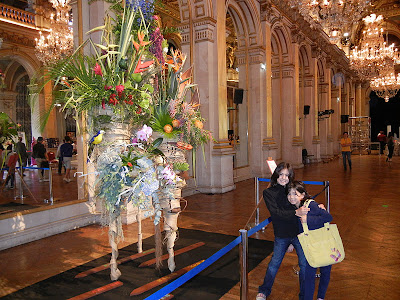Last week we visited the Musée Marmottan Monet with my sister Alina, who was visiting from Colombia, and my niece Laura, who's attending the University of Poitiers this semester and was in Paris for a few days before classes started. The museum contains a splendid collection of impressionist works, including the world's largest collection of Monet paintings.
The Marmottan building belonged to Jules Marmottan, a lawyer and avid collector, who later left it to his son Paul. Upon his death, Paul bequeathed the townhouse and all his collections and historical archives to the French Academy of Fine Arts, who opened up the house and collection as the Musée Marmottan in 1934.
The museum's impressive collection comes mainly from two major donations: the first, in 1957, from the daughter of Doctor Georges de Bellio, who was physician to Monet, Manet, Pissaro, Sisley and Renoir; and the second came directly from Claude Monet's second son, Michel, who in 1966 left the museum his own collection of his father's work, resulting in the biggest collection of Monet paintings in the world. There's a special exhibition space for the Monet collection in the lower level of the museum, which was inspired by the hall designed for Monet's Water Lilies murals in the Musée de l'Orangerie in Paris.




Michel Monet also donated the famous Monet house in the northwestern suburbs of Paris. You can buy a special two-day ticket that includes a visit to the house in Giverny, which we did, and the next day we took the 45-minute train ride with the whole family to Vernon, on the banks of the Seine, where two large buses were waiting outside the station to take us and more than 100 other people directly to Monet's house. Nobody knew we had to run to get in line for the buses, so we ended up having to wait for the two buses to deliver their passengers and come back to get the rest of us.
Monet discovered Giverny while traveling by train between Vernon and Gasny. In 1883 he decided to move there and rented a house, an old farmhouse. Monet eventually bought the house and lived there with his family till his death in 1926. The house was much smaller at the beginning; it was enlarged by Monet on both sides.
Gardening was Monet's other passion, and he conceived and created his water garden as well as his flower garden. We started the tour by walking around the water garden (Le Jardin d'Eau), which we've all seen many times in his paintings. As soon as you see the pond, with its beautiful water lilies perfectly arranged and floating peacefully, and lush willows and other vegetation surrounding it, you immediately get a sense of enchantment and can easily imagine the wonderful atmosphere and inspiration it provided Monet.
Two Japanese bridges, one at each end, are great places to take in the view, and take pictures of the pond, which explains why so many people were on them. After spending some time at the pond and taking the mandatory group picture, we toured the flower garden and the main house.
There's also a separate building, a huge studio that Monet built to paint his large format paintings, the famous Nymphéas (Water Lilies), which Monet donated to France after the signing of the Armistice in 1918 and are installed in a space designed specifically for them at the Musée de l'Orangerie. (We went to see them in November.)
After we left the house we grabbed some sandwiches and walked a bit around the village, then headed back to the train station to catch the 5:45 train back to Paris, where we ended the day with dinner at Café Monceau on Avenue de Villiers.



















































